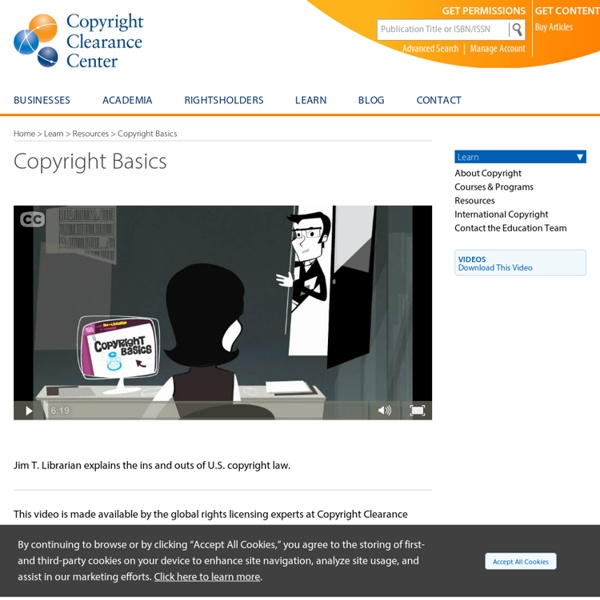



http://www.copyright.com/learn/media-download/copyright-basics/
Related: COLLECTION: CopyrightCopyright-CopyWrong The Educators' Lean and Mean No FAT Guide to Fair Use By Hall Davidson You can't afford to ignore the law, but neither can you afford to overlook the needs of your students. Fighting Plagiarism This article will focus on the importance of structuring research projects so they require original thought. The student will not just find an answer. The student will build an answer. A Copyright-Friendly Toolkit However fabulous Creative Commons and Public Domain content may be, sometimes you really need to use copyrighted material. Say you plan to comment on popular media or current events. For instance, you may be planning to critique the portrayal of Native Americans in commercial films. You are going to want to “quote” some commercial films like Pocahontas, Lone Ranger, and Dances with Wolves. If you are reviewing a book, you may want to share its cover art.
Educational Technology and Mobile Learning: copyright resources August 12, 2014 Now that the new school year is about to start, it would be great to devote a session with your students where you can talk to them about issues related to copyright and proper use of digital artifacts from the net. This will definitely help them make better and informed decisions as to the kind of materials they are allowed to use in their work and provide them with practice on the different ways they can appropriately credit sources. This resourceful page embeds a wide variety of materials to use in this regard, browse through the items featured there and bookmark the ones you plan to use with your students. Anti-Plagiarism Strategies Robert Harris Version Date: May 18, 2015 Earlier versions: December 30, 2013; February 28, 2012; December 18, 2010; June 14, 2009; November 17, 2004 The availability of textual material in electronic format has made plagiarism easier than ever. Copying and pasting of paragraphs or even entire essays now can be performed with just a few mouse clicks. The strategies discussed here can be used to combat what some believe is an increasing amount of plagiarism on research papers and other student writing. By employing these strategies, you can help encourage students to value the assignment and to do their own work.
What is Plagiarism? - Plagiarism.org Many people think of plagiarism as copying another's work or borrowing someone else's original ideas. But terms like "copying" and "borrowing" can disguise the seriousness of the offense: According to the Merriam-Webster online dictionary, to "plagiarize" means: to steal and pass off (the ideas or words of another) as one's own to use (another's production) without crediting the source to commit literary theft to present as new and original an idea or product derived from an existing source In other words, plagiarism is an act of fraud.
Free To Use and Share: Resources To Help Teach Kids (and Adults!) About Copyright and Creative Commons I've gotten a few requests lately for resources on how to teach kids (and adults!) about copyright. I've written before about how I don't think any lesson on copyright can be effective without an emphasis on creative commons and helping students choose licenses for their own work. Still, there are plenty of good resources out there to help start these conversations or that can serve as reminders as you help create a culture of creativity and attribution at your school.
Fair Use Scenarios The principles and limitations [of Fair Use] are designed to guide your reasoning and to help you guide the reasoning of others. "The Code of Best Practices in Fair Use" Center for Media & Social Impact It's long been my contention that you can't "teach" values. The best someone can do is create situations that help people define or refine their own values derived from information, conversation and reflection.
From Cop to Counselor Most of these columns, updated and edited, can be found in my book School Libraries Head for the Edge. Buy it and I might be able to afford a nicer nursing home one day. Thank you. Copyright and Primary Sources How do I use the Restriction Statements that accompany the American Memory collections? The Library of Congress assesses materials for legal considerations prior to placing items online (see legal assessment). The Restriction Statement that accompanies each American Memory collection provides known information regarding ownership of materials in the collection. If known, we include contacts for permission. In some cases the Restriction Statement will indicate that material in a particular collection may be used freely; in other cases the Restriction Statement may only be a starting point for your inquiry.
Should I be worried about piracy? I would discourage worrying of any kind as a general principle. Worrying is a fear that something bad might happen — a negative emotional state with no external cause in reality. So on that basis, no — I wouldn’t worry about piracy. I’d also suggest that piracy is not something that tends to happen on the scale that the mainstream media seems to suggest. Unauthorised duplication goes on, but not piracy. The idea that these two things are the same is one that major record labels tend to be quite fond of, but it bears no resemblance to either external reality, or what words actually mean.
The Ultimate Copyright Guide for Students: Basics You Should Know The Internet has brought the issue of copyright to the forefront like nothing else in history. The ease and speed with which people can share digital information has also made it very easy to commit copyright infringement, intentionally or not. In this guide, we cover copyright, plagarism, and the DMCA with specific references and insights for students. As a student, you have terabytes of data available literally at your fingertips, which makes project research and paper writing easier than they've ever been before. But it also means you must be more aware of copyright rules in order to avoid violating them.